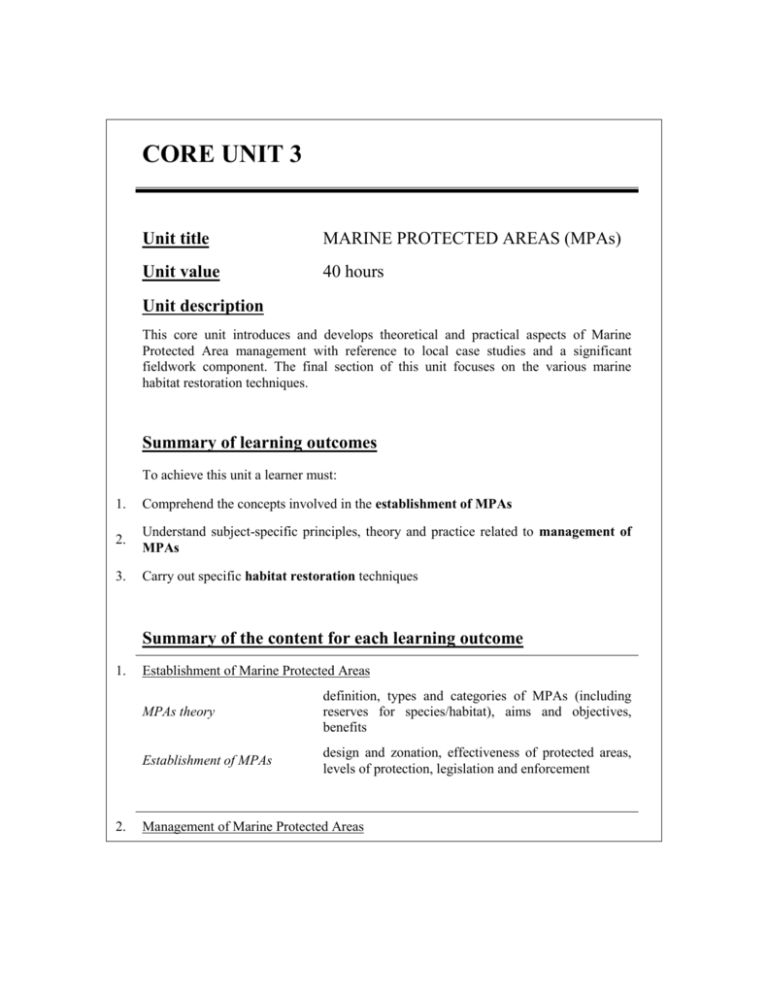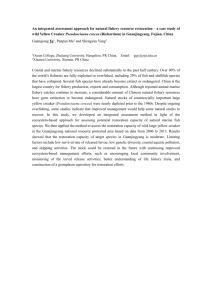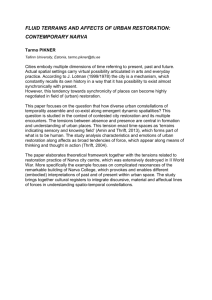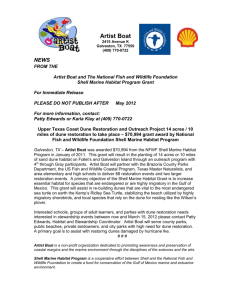Unit title: Marine and coastal tropical ecosystems
advertisement

CORE UNIT 3 Unit title MARINE PROTECTED AREAS (MPAs) Unit value 40 hours Unit description This core unit introduces and develops theoretical and practical aspects of Marine Protected Area management with reference to local case studies and a significant fieldwork component. The final section of this unit focuses on the various marine habitat restoration techniques. Summary of learning outcomes To achieve this unit a learner must: 1. Comprehend the concepts involved in the establishment of MPAs 2. Understand subject-specific principles, theory and practice related to management of MPAs 3. Carry out specific habitat restoration techniques Summary of the content for each learning outcome 1. 2. Establishment of Marine Protected Areas MPAs theory definition, types and categories of MPAs (including reserves for species/habitat), aims and objectives, benefits Establishment of MPAs design and zonation, effectiveness of protected areas, levels of protection, legislation and enforcement Management of Marine Protected Areas 1 . 3. Long term monitoring programmes importance of monitoring programmes in improving management, designing a monitoring programme (resource and capacity limit, appropriate indicators), types of monitoring programmes (habitats, fisheries, physical conditions, socio-economic) Surveillance and enforcement compliance issues, equipment for surveillance, surveillance tasks (i.e. respect of regulations and legislation, fees and licenses paid etc.), understanding the wider national legal framework, stakeholder involvement, training and appropriate behavior User conflicts types of conflicts, conflict resolution methods, steps in resolving a conflict Stakeholder consultations and the participatory approach to management levels of participation, participatory techniques Infrastructure construction vs. environment, main building and facilities, planning buildings (i.e. location, size, design, construction material etc.) Management structures strengths and weaknesses, co-management, community based management, top down/bottom up Financial planning and management various funding sources (i.e. trust funds, grant proposals writing, volunteer schemes, user fees), budgets, accounting, financial plans Evaluating success interest in marine protected area effectiveness evaluation, methodology identifying stakeholders, management Habitat restoration Choosing a restoration technique identifying aims and objectives, target area, ecological and logistical considerations, costs and benefits Carrying out a restoration technique coral transplant, mangrove and seagrass reseeding Assessment criteria for each learning outcome Learning outcomes Assessment criteria To achieve each outcome a learner must demonstrate the ability to: 1. Comprehend the concepts involved in the establishment of MPAs 2. Understand subject-specific principles, theory and practice related to management of MPAs 3. Carry out specific habitat restoration techniques Appreciate the importance of MPAs Give examples of the factors involved in setting up an MPA Appreciate the importance of long term monitoring programmes Show capacity to build a management plan from a hypothetical case study Plan a habitat restoration project Appreciate the importance of ecological and logistical considerations for habitat restoration Perform at least one habitat restoration technique proficiently Resources appropriate expedition and biological survey equipment, black/whiteboard, computer and projector, program CDs Suggested reading Marine Protected Areas Establishment of Marine Protected Areas International news and analysis on Marine Protected Areas: http://depts.washington.edu/mpanews/ Management of Marine Protected Areas Evaluating success Pomeroy RS et al. (2004) How is your MPA doing?: A guidebook of natural and social indicators for evaluating Marine Protected Area management effectiveness. IUCN, 215p. Pomeroy RS et al. (2005) How is your MPA doing? A methodology for evaluating the management effectiveness of marine protected areas. Ocean and Coastal Management 48(7-8):485-502 Financing MPAs Restoration Bosire JO et al. (2008) Functionality of restored mangroves: A review. Aquatic Botany 89(2):251259 Ellison AM (2001) Mangrove restoration: Do we know enough? Restoration Ecology 8(3):219-229 Kairo JG et al. (2001) Restoration and management of mangrove systems – a lesson for and from the East African region. South African Journal of Botany 67:383-389 Levy LSG et al. (2008) Fixed and suspended coral nurseries in the Philippines: Establishing the first step in the “gardening concept” of reef restoration. Journal of Experimental Marine Biology and Ecology 358(1):86-97 Lewis III RR and Gilmore RG (2007) Important considerations to achieve successful mangrove forest restoration with optimum fish habitat. Bulletin of Marine Science 80(3):813-837 Precht WF (2006) Coral Reef Restoration Handbook. CRC Press, 363pp. Rinkevich B (2008) Management of coral reefs: We have gone wrong when neglecting active reef restoration. Marine Pollution Bulletin 56(11):1821-1824 Ruiz-Jaen MC and Aide M (2005) Restoration success: How is it being measured? Restoration Ecology 13(3):569-577 Shafir S et al. (2006) Steps in the construction of underwater coral nursery, an essential component in reef restoration acts. Marine Biology 149(3):679-687 Stone K et al. (2008) Factors influencing community participation in mangroves restoration: A contingent valuation analysis. Ocean and Coastal Management 51(6):476-484 Sutthacheep TYM and Petttongma R (2006) Coral reef restoration projects in Thailand. Ocean and Coastal Management 49(9-10):562-575







